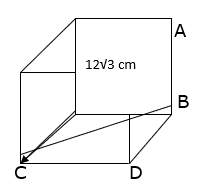Three cubes of a metal whose edge are in the ratio 3:4:5 are melted and converted into a single cube whose diagonal is 12 √3 cm. Find the edges of the three cubes.
Let the edges of metal cubes be a1, a2 and a3
And it is given that ratio of edges is 3:4:5
So, let a1 = 3x, a2 = 4x and a3 = 5x
Volume of cube with edge a1 = v1 = (a1)3
⇒v1 = (3x)3
∴ v1 = 27x3 cm3→eqn1
Similarly
Volume of cube with edge a2 = v2 = (a2)3
⇒v2 = (4x)3
∴ v2 = 64x3 cm3→eqn2
Volume of cube with edge a3 = v3 = (a3)3
⇒v3 = (5x)3
∴ v3 = 125x3 cm3→eqn3
Now let the volume of resulting cube be ‘V’ cm3
So, V = v1 + v2 + v3
⇒ V = 27x3 + 64x3 + 125x3 (from eqn1, eqn2 and eqn3)
∴ V = 216x3 cm3→eqn4
It is given that the diagonal of the resulting cube is 12√3 cm

Let the edge of resulting cube be ‘a’ cm
Consider ΔBCD, ∠BDC = 90°
BD = CD = a cm (as they are the edges of cube)
![]()
⇒ BC2 = a2 + a2 (putting value of BD and CD)
⇒BC2 = 2a2
⇒BC = √(2a2)
∴ BC = a√2 cm
Now consider ΔABC, ∠ABC = 90°
Here, AB = a cm and BC = a√2 cm and AC = 12√3 cm
![]()
⇒(12√3)2 = a2 + (a√2)2 (putting values of AB, AC and BC)
⇒ 144 × 3 = a2 + 2a2
⇒ 144 × 3 = 3a2
⇒ 144 = a2
⇒ a = √144
∴ a = 12 cm
So, volume of the resulting cube = V = a3
⇒ V = 123 (putting value of a)
∴ V = 1728 cm3 –eqn5
Equate equation 4 and 5
⇒ 216x3 = 1728
⇒ x3 = 1728/216
⇒ x3 = 8
⇒ x = ∛8
∴ x = 2
So a1 = 3x = 3 × 2
⇒ a1 = 6 cm
Similarly a2 = 4x = 4 × 2
∴ a2 = 8 cm
Similarly a3 = 5x = 5 × 2
∴ a3 = 10 cm
The edges of three cubes are 6 cm, 8 cm and 10 cm.